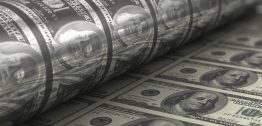The root cause of the Great Financial Crisis can be summed up in one word. Insolvency.
Unfortunately, when U.S. subprime mortgages and derivatives imploded, investors panicked and financial markets seized. Yet almost a decade has passed, and insolvency remains.
It’s been hidden this whole time – by liquidity.
It’s the reason central banks are reluctant to “normalize” monetary policy. When the world is faced with rising interest rates, liquidity will recede and insolvency will be exposed.
Surely, we all remember the European sovereign-debt saga.
It taught us how liquidity can drive down the risk premium on financially fragile countries like Greece, Spain and Italy. It seemed the risk of lending money to those sovereigns was a lot lower than it really was.
Clearly, that wasn’t true.
And investors faced that sobering reality when those premiums blew open and when sovereign debts traded more appropriately with the underlying risk they carry.
Years later, the financial markets could crack with even the slightest policy miscue by the European Central Bank or the Federal Reserve.
Bank of America credit analysts are on the case. They point out that liquidity is not what it once was in the corporate-debt market.
In the past 10 years, trading volumes in corporate debt have gone up. But volumes as a percentage of total market fell from 135% in 2006 to 86% this year.
This means easily traded bonds make up a smaller portion of the debt that investors are holding.
And that’s because easy money and low interest rates sent investors in search of returns in riskier assets.
Investors feel safe seeking out less-liquid – aka, riskier – bonds to secure returns. As a result, there’s not much difference in how the market is pricing the risk between more-liquid and less-liquid debt.
Current option adjusted spreads (below) are way below historical averages.

That sounds a lot like the European sovereign-debt crisis, doesn’t it?
Going forward, liquidity in the corporate-debt market might not be a problem.
If policymakers can keep interest rates low and asset purchases intact, it’s probably business as usual.
But if they can’t or don’t, then rising interest rates will shake up corporate debt.
Worst case: The global financial system could freeze up the way it did in 2008. At the very least, there would be isolated crises where debt is most precarious.
Look no farther than Europe …
In Italy, 18% of loans are non-performing. Martin Weiss recently visited Italy and filmed a short video outside UniCredit Banca in Milan. He returned with a warning: Italy could be the epicenter of the next global crisis.
Across Europe, non-performing loans (NPLs) still amount to 1 trillion euros and the ratio of bad debt is 5.5%. That’s double the ratio in the United States.
Unlike the Fed, the ECB uses its quantitative-easing program to buy debt of European companies. A cool 600 companies, to be exact.
Bank of America classifies 50 of those companies as “zombies” because they pay too much interest relative to their profits. They’re in trouble when the ECB tapers its purchases and interest rates begin rising.
The ECB told us last week they’ve begun discussing how and when to taper their asset purchases. Does that mean they’ll also entertain benchmark rate hikes? Will the market anticipate the inevitable by driving rates higher?
European high-yield spreads have tightened to levels not seen since 2007. High-grade corporate bonds are also near extreme lows. Overall, corporate net debt-to-GDP has risen from 92% to 104%.
From just a valuation standpoint, it doesn’t seem like European corporate debt of any grade is worth the risk.
Systemically speaking, European debt has the potential to spark another global crisis if policymakers can’t keep hold of interest rates expectations.
Markets are behaving as if policymakers have everything under control. But if liquidity disappears, all bets are off.
Do right,
JR Crooks



Glenn Melcher October 10, 2017
Thank you for sharing this candid insight.. Have we not seen this before..
Jay September 17, 2017
what happens to the dollar when the EU collapses? At the moment the dollar is going going down vis a vis the euro or the pound. If the Dow is bought 2018 will the value tank when the dollar goes down; it certainly seems to be happening to the value of gold always in dollars but bought in euros
Stephen Ettinger September 16, 2017
To my publisher who I pay for information. I work full time for a living. I have close to ZERO time to read, which is my Train reading. You put 3 videos out there to educate us on the 4 phases of where the next 5 years is going to lead us. I took almost 2 hours between reading and watching videos and…….. did more reading about everything we have read over the last 6 months in a free K-Wave Guide which Larry Edelstein gave us 2 years ago. Talk about a waste of time, and redundancy!! It is valued information that you do share with your readers. Assisting us as investors who make financial decisions with informed updated intel is a comfort – No Doubt. What is most disturbing is you tell us after your 3rd video to go to the free 4 phase guide which road maps specific areas to invest in. – YOU DIDNT NAME ONE. the writing I read for free reinforced what the 3rd video shared. Word for word. You highlighted and brushed on topics as an overview. You captured your readers, and clients, and then hit us in the face with another PUBLICATION THAT IS GOING TO COST us $2,000.00. You believe a 5 year program for $2,000.00 is going to make us successful ——— Very clever. I am a life reader with Edelsons Wave. I have lost a boat load of money purchasing products that have tanked over the years, and now I am doing all I can to recoup these losses. Why don’t you offer people a 6 month trail subscription for $250.00 and if we do well, Based upon THIS OCTOBERS COLLAPSE, we can make some money, and then pay you for a full year for $500.00 $2,000 is a lot of money for an average investor. That is IRA Money, College Fund money for my kids, money for my rediculous Property taxes on Long island. I don’t live in the swamps of Florida, and pay $1,200 a year in taxes. My property tax base is close to $13,000 a year! If your firm is so sure this new publication is going to save the lives of many – Financially speaking……. offer a 6 month trial for $250.00. If it continues, add $500.00 That is $750.00 for 1 full year. Do it the second year. Do it the 3rd year. Now yo have 3 years paid for by people like me who can afford this way of paying, Year 4 and 5 is free. I want this publication but cannot afford $2,000.00. – SO COME UP WITH A PLAN TO SPREAD IT OUT AND I AM IN. Can yo do that?
Dirk Breugelmans September 16, 2017
Mr. Crooks,
Congratulations with your article, i am living in Belgium so 99.9 % of the Europeans are not aware of this systemic problem.
Peter Praet (ECB) this weekend in “de tijd ” (our financial newspaper) i quote ” most of the people are not aware what we dit , we lived in an entirely different world !
https://www.tijd.be/politiek-economie/europa-economie/Zonder-ons-harde-optreden-had-de-wereld-er-nu-ingrijpend-slechter-uitgezien/9933080
kind regards,
Dirk Breugelmans
Prov. Anwerp
Belgium
revmurphy3 September 15, 2017
This financial judgment day article makes good sense. I guess I’ll keep my subscription and try
to separate the worthwhile from the worthless.
This year I bought Gold in late Spring because of the coming disaster and lost money. I did the same
thing this summer. Every time I bought gold was in response to the crash that was at hand. And every time
the crash failed to show up.
However my stocks have done very well. I have tripled earnings while the S&P
never grew past single points. I relied more on the advice of the bulls than the bears. The bears always
ate my money while the bulls knocked it out of the park. I’m feeding the bulls for the rest of the year in spite
of all the doom and gloom being spread these days.